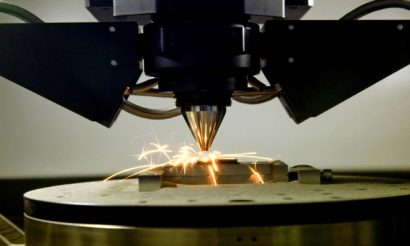Novel dispense tech could unlock ‘mass personalisation’
- Like
- Digg
- Del
- Tumblr
- VKontakte
- Buffer
- Love This
- Odnoklassniki
- Meneame
- Blogger
- Amazon
- Yahoo Mail
- Gmail
- AOL
- Newsvine
- HackerNews
- Evernote
- MySpace
- Mail.ru
- Viadeo
- Line
- Comments
- Yummly
- SMS
- Viber
- Telegram
- Subscribe
- Skype
- Facebook Messenger
- Kakao
- LiveJournal
- Yammer
- Edgar
- Fintel
- Mix
- Instapaper
- Copy Link
Posted: 24 January 2017 | Iain Ansell, Managing Director, Sagentia | No comments yet
Iain Ansell, Managing Director, Sagentia grants an excellent insight into how novel dispense tech could unlock ‘mass personalisation’ in future…


Iain Ansell, Managing Director, Sagentia grants an excellent insight into how novel dispense tech could unlock ‘mass personalisation’ in future…
Anticipating and delivering on evolving consumer demands is never easy.
How do you predict the next big thing, how do you know if it will be a lasting change or a fad, how and when do you adapt your core offering?
This is a common challenge across all retail industries, and the food and beverage sector is no exception.
According to a study conducted by Sagentia’s sister company Leatherhead Food Research, a major driver of innovation in the sector today is consumer appetite for personalisation. In-depth interviews with innovation professionals at 27 leading global brands revealed widespread acknowledgement of a need for more individualised products and services. Large, established brands are painfully aware that leaner start-ups are often better placed to deliver this. They can respond quickly to the evolving consumer landscape and create products directly tailored to individual customers and their of-the-moment needs.
A major problem for established brands is finding ways to achieve the same when their manufacturing systems are geared up for mass production. They are forced to operate within the capabilities of legacy equipment, which can put a stranglehold on innovation. On the flipside, smaller brands that have built their reputation on personalisation need to replicate this at a macro level if they want to grow and develop new territories.
Consumer demand for personalised experiences looks set to be a lasting trend that will manifest itself in many ways. Offering personalisation to the masses is therefore a challenge that food and beverage brands of all sizes and backgrounds may need to consider.
Fortunately, a convergence of technology and data developments offers the potential to unlock new approaches and production methods. From robotics to big data engineering, device connectivity to 3D printing, the baseline capabilities for ‘mass personalisation’ already exist.
“Smaller brands that have built their reputation on personalisation need to replicate this at a macro level if they want to grow…”
There are signs that on-demand novel dispensing, where consumers engage with vending machines to create tailored products in real-time, could become a viable way to achieve this. Conversations Sagentia is having with progressive food and beverage brands indicate that novel dispense for customised vending could become a significant area of innovation over the coming decade.
What will mass personalisation look like?
Leatherhead’s research revealed that personalisation is not necessarily about changing the core product; the way it is packaged and delivered can also play a role. Think about Coca-Cola Freestyle. Consumers can tinker with the same core product to create 127 beverage variations. This concept could be adapted and developed to deliver highly-personalised experiences across the wider food and beverage industry. How about machines that fry and flavour potato chips on-demand, so they can be tailored to an individual’s tastes and enjoyed fresh? Or cakes and cookies with personal messages piped in icing by a robot before your eyes?
The concept can extend beyond soda and snacks to cover health-related choices or meals on the go. Modifications could be made to salt and sugar content; portion size could be adapted in-line with a person’s age or required calorie intake. Business parks and office blocks could be an ideal location for customised vending of soup or noodle dishes, with people pre-ordering via their smartphone to collect when their lunchbreak begins.
Vending machines could also cater for people with specific requirements surrounding sports nutrition or vitamin and mineral intake. Connectivity with personal smart devices might allow machines to make recommendations based on individuals’ previous choices, level of physical activity that day, or quality of sleep the previous night.
How will it be achieved?
The digital age has both escalated consumer expectation for personalisation and provided some of the tools to help deliver it. There is scope for vending machines to function as localised ‘just in time’ manufacturing centres, providing an antidote to commoditised mass production. The manufacturer delivers ingredients, or part-processed materials, to the machine so they can be adapted and finished in situ to meet the customer’s preferences.


Robotics technologies are vastly improving and 3D printing and 3D slicers are beginning to make inroads to the food industry as price points become more competitive. As these technologies become more advanced and cost-effective, they offer much potential for on-demand food production.
What’s more, as connectivity between devices becomes more sophisticated, there are new possibilities to connect with customers to deliver a highly-tailored experience. Monitoring and servicing of connected equipment is also becoming more reliable and practical, so if there’s a surge in demand for a given variation of a custom-vended product, the base materials can be replenished in good time.
Wider considerations
While the baseline technology for customised vending exists, taking concepts to market will inevitably bring technical challenges. Mixing and dispensing ingredients will involve complex mechanisms. Engineering these to achieve required robustness, especially in early machine generations, will take significant design effort and validation. Issues surrounding hygiene and cleanliness will also be a major consideration. And practical matters such as ingredients supply may need ongoing refinement to strike the right balance between freshness and efficiency.
However, the marriage of novel dispense and customised vending could also bring associated benefits. Finishing products at the point of sale cuts down on supply chain packaging. If they are for immediate consumption, a simple paper bag or serviette may be suitable, rather than foil or plastic containers. This could be a major advantage for brands looking to improve their sustainability credentials. What’s more, producing food in this way could in some cases reduce the need for preservatives and additives.
Future developments
There are several brands already delivering on this vision: the Let’s Pizza vending machine offering freshly made pizzas with a choice of toppings, Reis and Irvy’s frozen yogurt robot, the customised Oreo cookies robot. These machines are not yet widely available, but the technology is there and as consumers embrace the concept, uptake will gather pace.


Markets such as Japan, where vending machines have historically been popular, are likely to lead the way. Wider success will hinge on a shift in consumer behaviour as well as technology developments, but acceptance of concepts like Amazon Locker are paving the way. As we head into the 2020s, on-demand novel dispensing via vending machines is likely to become increasingly mainstream.
As Bill Gates said in his 1996 book ‘The Road Ahead’:
“We always overestimate the change that will occur in the next two years and underestimate the change that will occur in the next ten. Don’t allow yourself to be lulled into inaction.”








